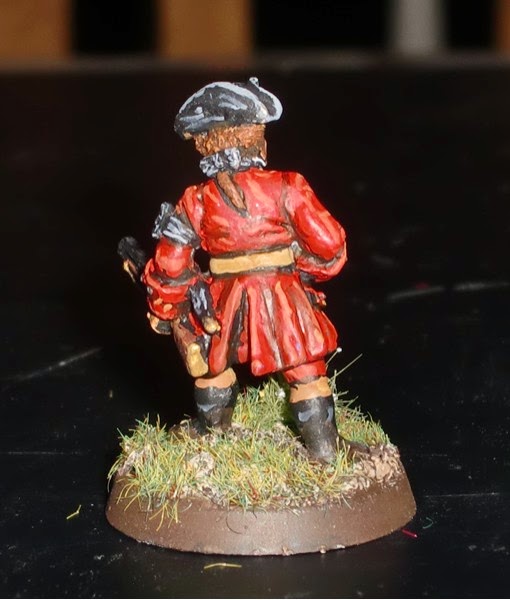Richard III is still King of England! Thanks to buddies Scott A., Pat, Keith, and
Kimo, the Bosworth game finally played out using a much-modified version of
Hail Caesar. The usurper, Henry Tudor (played by Pat) and the
Earl of Oxford (played by Keith) were defeated by the forces of Richard and the Duke of Norfolk (played by Kimo), and the loyal support
of the Stanleys (played by Scott A.). Now Pat rolling two Blunders in the 6 Turn game did
not help the Tudor cause. And to be fair, the so-called Welsh Milksop
fought courageously - even charging the Yorkists forces on Ambion Hill.
 |
| Turn 2 has the Yorkists cautiously moving down the slopes of Ambion Hill. The forces of the Duke of Norfolk in the center, and Richard's cavalry on their left. The Earl of Northumberland still remains on the Hill. He would soon leave the field, causing the Stanleys to join the forces of Richard (see below mechanics for this odd behavior) |
|
Kimo being a prudent commander did not have the Duke of Norfolk charge down Ambion Hill into the forces of the Earl of Oxford - as it was done in history. This caused the Tudor forces to advance toward the defensive position of the Yorkist. Turn 3 had Northumberland leave the field, causing the Stanleys to join Richard. In retrospect, it may be more appropriate to have the Stanleys join Henry if Northumberland were to leave the field.
 |
| The Earl of Oxford's battle moving toward Ambion Hill - after taking some casualties from Yorkists missile fire. |
|
Henry, aware of the Stanleys siding with Richard, decided to mount an attack on the Yorkists on Ambion Hill.
 |
| Henry and his cavalry charge into Norfolk's battle - no milksop here. Richard and his mounted forces are on Henry's right - on the move to flank Henry's forces. |
|
 |
| The Stanleys advancing in support of Richard - skirting around the dreaded marsh. | |
|
 |
| Oxford's battle at the base of Ambion Hill - attempting to engage Norfolk. |
|
 |
| Top of Turn 6 had Pat rolling another Blunder and subsequently having Henry turning and fleeing; ending Henry's bid for the Crown of England. |
|
 |
| A gratuitous shot of the missile troops killed off in battle - lining the River Styx. |
|
The general mechanics for this game worked to my satisfaction - as I was confident they would as they were pretty much the same for the successful Siege of Haengju game. The victory conditions were simple enough - death of either Richard or Henry by Turn 6. However, the added element of the Stanleys loyalty/disloyalty toward Richard could be improved. The rules for the Stanleys used in this game are below:
* If Richard advances, Northumberland rolls 1D6:
1-3 = Northumberland quits the field
4-6 = Northumberland remains in place
* If Northumberland quits the field,
the Stanleys will join Richard and attack Henry (this is what happened in the game)
* If Northumberland remains in place,
after King Richard commits any part of his battle, then the Stanleys roll 1D6:
1-2 = Stanleys attack Henry
3-6 = Stanleys attack Richard
* If Richard can avoid committing his
main battle, i.e. defeat Henry with just Norfolk’s battle, then Northumberland
remains in place well to the rear, and the Stanleys also remain in place.
For what it's worth, here are the rules used for the game - of course, there was some tweaking during the game. One being the use of commanders in combat - pretty much a combination of Hail Caesar and WAB rules. They couldn't be targeted by missile fire, but could engage in Combat with attendant peril.
These core rules can easily be modified (as they were in the first place) or given more detail to add flavor and depth as desired. That all said, I intend to put this on the back-burner for a bit as I need to prepare for Muskets and Tomahawks game I'm hosting at a game day in a few weeks.




















































